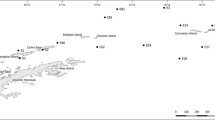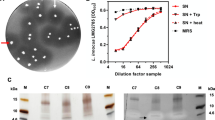Abstract
Andrimid, a known non-ribosomal pseudo-peptide antibiotic, was isolated from a psychrotolerant Serratia proteamaculans strain. The antibiotic peptide was produced at low temperature (8 °C) in a 7.5 l BIOFLO 101 bioreactor under batch culture mode. Andrimid activity from S. proteamaculans culture was only detected at 25 °C and below and potent antibacterial activity was revealed against both, pathogenic and non-pathogenic bacteria. Minimal inhibitory concentration values determined by microdilution experiments varied in the range between 0.01 and 0.78 μg/ml. Antimicrobial purification and structure elucidation were carried out by LC-MS/MS and 1H/13C NMR approaches. The effects on the ultrastructure of sensitive Escherichia coli 35,218 cells were observed by transmission electron microscopy at different inhibition stages. This work demonstrated the significance of bioprospection from cold environments through the screening of microorganisms with ability to produce cold-active biomolecules of biotechnological interest. S. proteamaculans 136 was revealed as a novel microbial source for andrimid production at low temperatures, showing biotechnological potential to be applied in cryopreservation, food or cosmetic industries against pathogenic bacteria.



Similar content being viewed by others
References
Antranikian G, Vorgias CE, Bertoldo C (2005) Extreme environments as a resource for microorganisms and novel biocatalysts. Adv Biochem Eng Biotechnol 96:219–262
Aravalli RN, She Q, Garrett RA (1998) Archaea and the new age of microorganisms. Trends Ecol Evol 13:190–194
Böcker S, Letzel MC, Liptak Z, Pervukhin A (2009) SIRIUS: decomposing isotope patterns for metabolite identification. Bioinformatics 25:218
Davies J, Webb V (1998) Antibiotic resistance in bacteria. In: Krause RM (ed) Emerging infections. Biomedical research reports San Diego. Academic Press, CA
Feller G, Zekhnini Z, Lamotte-Brasseur J, Gerday C (1997) Enzymes from cold-adapted microorganisms the class C ß-lactamase from the antarctic psychrophile Psychrobacter immobilis A5. Eur J Biochem 244:186–191
Fischbach MA (2009) Antibiotics from microbes: converging to kill. Curr Opin Microbiol 12:520–527
Fredenhagen A, Tamure SY, Kenny PTM, Komura H, Naya Y, Nakanishi K (1987) Andrimid, a new peptide antibiotic produced by an intracellular bacterial symbiont isolated from a brown planthopper. J Am Chem Soc 109:4409–4411
Freiberg C, Brunner N, Schiffer G, Lampe T, Pohlmann J, Brands M, Raabe M, Häbich D, Ziegelbauer K (2004) Identification and characterization of the first class of potent bacterial acetyl-CoA carboxylase inhibitors with antibacterial activity. J Biol Chem 279:26066–26073
Gootz TD (1990) Discovery and development of new antimicrobial agents. Clin Microbiol Rev 1:13–31
Hacker J, Blum-Oehler G, Mühldorfer I, Tschäpe H (1997) Pathogenicity islands of virulent bacteria: structure, function and impact on microbiol evolution. Mol Microbiol 23:1089–1097
Holden MTG, Feil EJ, Lindsay JA, Peacock SJ, Day NP, Enright MC, Foster TJ, Moore CE, Hurst L, Atkin RA, Barron A, Bason N, Bentley SD, Chillingworth C, Chillingworth T, Churcher C, Clark L, Corton C, Cronin A, Doggett J, Dowd L, Feltwell T, Hance Z, Harris B, Hauser H, Holyroyd S, Jagels K, James KD, Lennard N, Line A, Mayes R, Moule S, Mungall K, Ormond D, Quail MA, Raddinowitsch E, Rutherford K, Sanders M, Sharp S, Simmonds M, Stevens K, Whitehead S, Barrell BG, Parkhill J (2004) Complete genomes of two clinical Staphylococcus aureus strains: evidence for the rapid evolution of virulence and drug resistance. Proc Natl Acad Sci USA 101:9786–9791
Hugenholtz P, Pace NR (1996) Identifying microbial diversity in the natural environment: a molecular phylogenetic approach. Trends Biotechnol 14:190–197
Jin M, Fischbach MA, Clardy J (2006) A biosynthetic gene cluster for the acetyl-CoA carboxylase inhibitor andrimid. J Am Chem Soc 128:10660–10661
Kabuki T, Uenishi H, Watanabe M, Seto Y, Nakajima H (2007) Characterization of a bacteriocin, Thermophilin 1277, produced by Streptococcus thermophilus SBT1277. J Appl Microbiol 102:971–980
Liu XY, Fortin PD, Walsh CT (2008) Andrimid producers encode an acetyl-CoA carboxyltransferase subunit resistant to the action of the antibiotic. Proc Natl Acad Sci USA 105:13321–13326
Long RA, Rowley DC, Zamora E, Liu JY, Bartlett DH, Azam F (2005) Antagonistic interactions among marine bacteria impede the proliferation of Vibrio cholerae. Appl Environ Microbiol 71:8531–8536
Mansson M, Gram L, Larsen TO (2011) Production of bioactive secondary metabolites by marine Vibrionaceae. Marine drugs 9:1440–1468
Matsuyama T, Murakami T, Fujita M, Fujita S, Yano I (1986) Extracellular vesicle formation and biosurfactant production by Serratia marcescens. J Gen Microbiol 132:865–875
Matsuyama T, Bhasin A, Harshey RM (1995) Mutational analysis of flagellum-independent surface spreading of Serratia marcescens 274 on a low-agar medium. J Bacteriol 177:987–991
Mayr-Harting A, Hedges A, Berkeley RCW (1972) Methods for studying bacteriocins. In: Norris JR, Ribbons DW (eds) Methods in microbiology 7a. Academic Press, London, pp 315–422
Needham J, Kelly MT, Ishige M, Andersen RJ (1994) Andrimid and moiramides A-C, metabolites produced in culture by a marine isolate of the bacterium Pseudomonas fluorescens: structure elucidation and biosynthesis. J Org Chem 59:2058–2063
Neumann S, Böcker S (2010) Computational mass spectrometry for metabolomics Identification of metabolites and small molecules. Anal Bioanal Chem 398:2779–2788
O’Brien A, Sharp R, Russell N, Roller S (2004) Antarctic bacteria inhibit growth of food-borne microorganisms at low temperatures. FEMS Microbiol Ecol 48:157–167
Oclarit JM, Okada H, Ohta S, Kaminura K, Yamaoka Y, Lizuka T, Miyashiro S, Ikegami S (1994) Anti-bacillus substance in the marine sponge, Hyatella species, produced by an associated Vibrio species bacterium. Microbios 78:7–16
Pesciaroli C, Cupini F, Selbmann L, Barghini P (2012) Temperature preferences of bacteria isolated from seawater collected in Kandalaksha Bay, White Sea, Russia. Polar Biol 35:435–445
Pohlmann J, Lampe T, Shimada M, Nell PG, Pernerstorfer J, Svenstrup N, Brunner NA, Schiffer G, Freiberg C (2005) Pyrrolidinedione derivatives as antibacterial agents with a novel mode of action. Bioorg Med Chem Lett 15:1189–1192
Prangishvili D, Holz I, Stieger E, Nickell S, Kristjansson JK, Zillig W (2000) Sulfolobicins, specific proteinaceous toxins produced by strains of the extremophilic archaeal genus Sulfolobus. J Bacteriol 182:2985–2988
Sánchez LA, Gomez FF, Delgado OD (2009) Cold-adapted microorganisms as a source of new antimicrobials. Extremophiles 13:111–120
Sánchez LA, Hedström M, Delgado M, Delgado OD (2010) Production, purification and characterization of Serraticin A, a novel cold-active antimicrobial produced by Serratia proteamaculans 136. J Appl Microbiol 109:936–945
Savino JM, Sanchez LA, Saguir FM, Manca de Nadra MC (2012) Lactic acid bacteria isolated from apples are able to catabolise arginine. World J Microbiol Biotechnol 28:1003–1012
Singh MP, Menendez AT, Petersen PJ, Ding WD, Maiese WM, Greenstein M (1997) Biological and mechanistic activities of phenazine antibiotics produced by culture LL-14I352. J Antibiot 50:785–787
Smith-Palmer A, Stewart J, Fyfe L (1998) Antimicrobial properties of plant essential oils and essences against five important food-borne pathogens. Lett Appl Microbiol 26:118–122
Souza NJ, Ganguli BN, Reden J (1982) Strategies in the discovery of drugs from natural sources. Annu Rep Med Chem 17:301–310
Spizek J, Novotna J, Rezanka T, Demain AL (2010) Do we need new antibiotics? The search for new targets and new compounds. J Ind Microbiol Biotechnol 37:1241–1248
Szczepanowski R, Braun S, Riedel V, Schneiker S, Krahn I, Puhler A, Schlüter A (2005) The 120 592 bp IncF plasmid pRSB107 isolated from a sewage-treatment plant encodes nine different antibiotic-resistance determinants, two iron-acquisition systems and other putative virulence-associated functions. Microbiology 151:1095–1111
Tanaka Y, Yuasa J, Baba M, Tanikawa T, Nakagawa Y, Matsuyama T (2004) Temperature-dependent bacteriostatic activity of Serratia marcescens. Microbes Environ 19:236–240
Thomson NR, Crow MA, Crow SJ, McGowan A, Salmond GPC (2000) Biosynthesis of carbapenem antibiotic and prodigiosin pigment in Serratia is under quorum sensing control. Mol Microbiol 36:539–556
Venable JH, Coggeshall R (1965) A simplified lead citrate stain for electron microscopy. J Cell Biol 25:407–408
Wenzel RP (2004) The antibiotic pipeline challenges, costs, and values. New Engl J Med 351:523–526
Wietz M, Mansson M, Gotfredsen CH, Larsen TO, Gram L (2010) Antibacterial compounds from marine Vibrionaceae isolated on a global expedition. Mar Drugs 8:2946–2960
Wietz M, Månsson M, Gram L (2011) Chitin stimulates production of the antibiotic andrimid in a Vibrio coralliilyticus strain. Environ Microbiol Rep 3(5):559–564
Williams RP, Quadri SMH (1980) The pigment of Serratia. In: von Gravenitz A, Rubin SJ (eds) The genus Serratia. CRC Press, Boca Raton, Fla, pp 31–75
Yaron S, Rydlo T, Shachar D, Mor A (2003) Activity of dermaseptin K4–S4 against foodborne pathogens. Peptides 24:1815–1821
Yu VL (1979) Serratia marcescens, historical perspective and clinical review. New Engl J Med 300:887–893
Zahner H, Fielder HP (1995) The need for new antibiotics: possible ways forward In: Hunter PA, Darby GK, Russell NJ (eds) Fifty years of antimicrobials: past perspectives and future trends. Cambridge SGM Symp, vol. 53. Cambridge University Press, pp 67–83
Author information
Authors and Affiliations
Corresponding author
Electronic supplementary material
Below is the link to the electronic supplementary material.
Rights and permissions
About this article
Cite this article
Sánchez, L.A., Sierra, M.G., Siñeriz, F. et al. Andrimid production at low temperature by a psychrotolerant Serratia proteamaculans strain. World J Microbiol Biotechnol 29, 1773–1781 (2013). https://doi.org/10.1007/s11274-013-1338-9
Received:
Accepted:
Published:
Issue Date:
DOI: https://doi.org/10.1007/s11274-013-1338-9




